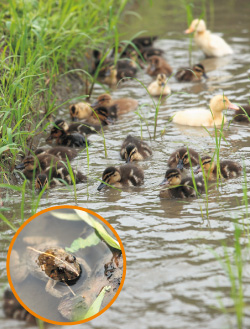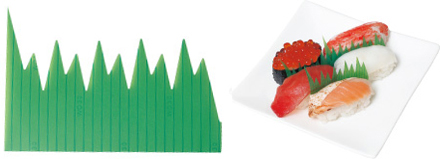niponica is a web magazine that introduces modern Japan to people all over the world.
2013 No.10

To read the e-book you need to have JavaScript enabled in your browser and a free Flash Player plug-in from Adobe Systems Inc. installed.
Quality with a Japanese Flair

Keeping Food Tasty and Safe
Agricultural chemicals and radioactive substances are known to have an adverse effect on the human body, and some bacteria and other microbes cause food poisoning. These problems threaten food safety, but Japan is rising to the challenge, as these pages show.
Photos by Natori Kazuhisa and Murakami Keiichi
Photos courtesy of the Fukushima prefectural government

About 1,400 duck chicks frolic in his rice fields (area: 7 hectares).
Safe and tasty rice, thanks to ducks
A wide range of organic farming methods have been tried in Japan, all, of course, without depending on agricultural chemicals. The long-held dream—and difficult challenge—of the Japanese is to grow tasty rice the organic way.
A flight from Tokyo lasting about two hours will take you to northern Kyushu, and from the airport there you are not far from Keisen-machi in Fukuoka Prefecture, a place of unusual agricultural vistas, shimmering in bright green in early summer. Cute waterfowl dart about on the water flooding the rice fields, pecking away cheerfully at weeds and insects. They are ducks, participants in a rice-duck farming method first developed more than 20 years ago by Furuno Takao. He is the owner of these fields, and a veteran organic farmer.
Organic farming takes a great deal of time and labor, making high-volume harvests difficult to achieve. This is especially true for rice farming, which requires a large area and the elimination of weeds and pesky insects. So Furuno hit upon the riceduck farming method.
Rice fields end up being a welcoming habitat for many types of plants and creatures, so it is natural to find weeds and insects there. "They are enemies for the farmer, but they become food for ducks raised along with the rice plants. Not only that, the duck droppings make great fertilizer. This method increases biodiversity in the rice field ecosystem, and it improves productivity, too," explains Furuno.
His approach to farming starts with the desire to grow tasty, healthy food for himself and his family, and this desire inspires his efforts to supply the same type of food to others.
The rice-duck farming method is spreading to different parts of Japan and to other parts of Asia where rice is grown, such as China, the Philippines and India. "My hope is that, as this method spreads to different regions, we'll teach each other, and then the method can spread even more, developing into a form of technical know-how shared across Asia."
Targeting a food renaissance in Fukushima
People on a cherry picking tour organized under the Fukushima Shinhatsubai ("Now On Sale") program. Results of tests for radioactive substances are posted on the program's website:
http://www.new-fukushima.jp/monitoring/en/
Upland areas and mountain ranges in Fukushima Prefecture tend to have a north-south orientation, making for a variety of microclimates, each nurturing one bountiful crop or another. The result is a rich variety of specialty products, including rice, vegetables (especially cucumbers and tomatoes), and fruit such as peaches, nashi pears and apples.
The prefecture bore the brunt of the 2011 accident at the Fukushima Daiichi Nuclear Power Station, and monitoring for radioactive substances continues. The national government's accepted limit for radioactive cesium in food for general consumption is 100 becquerels per kilogram. All rice grown in the prefecture, including that grown by farmers for their own consumption, is tested. Farm produce destined to be shipped for sale must first be tested—it is taken to the Fukushima Agricultural Technology Center and examined that day or the next, to determine whether it can be marketed. If a food sample exceeds the accepted limit, the entire harvest it came from, along with the crop scheduled to be harvested from the fields in question, is discarded, and thus kept off the market. According to research done by Fukushima Prefecture's Department of Agriculture, Forestry and Fisheries, immediately after the accident, plants being grown for food temporarily exceeded the accepted limit due to fallout, but crops grown later have remained below that.
The prefectural government launched a program called Fukushima Shinhatsubai ("Now On Sale") to inform the public about its safeguard efforts and current conditions. Monitoring results are published on the government website, and the public is invited to observe monitoring tests and participate in cherry picking and rice harvesting. The Department of Agriculture, Forestry and Fisheries, which organizes these programs, is keen for the public to come to Fukushima Prefecture, observe, and learn first-hand from the experience.
Fukushima's government continues these efforts, keen to reestablish the prefecture's reputation as a source of tasty, safe food.
A traditional ingredient joins forces with modern technology for food safety
One specialty product of Japan, wasabi, is a condiment that packs an invigorating bite and unique aroma that will startle an unsuspecting nose. It has highly effective antibacterial qualities, so before the days of refrigeration it was used as a seasoning for sushi to prevent food poisoning, and stored with mochi rice cakes to prevent mold. Wasaouro™ is an antibacterial agent that takes advantage of this kind of know-how. Its main antimicrobial constituent, allyl mustard oil, is included in plastic sheets that are used in diverse ways, like protective film and imitation green leaf food dividers for lunch boxes. And so, a food product steeped in tradition is taking a new shape for use as a modern agent for food safety.







